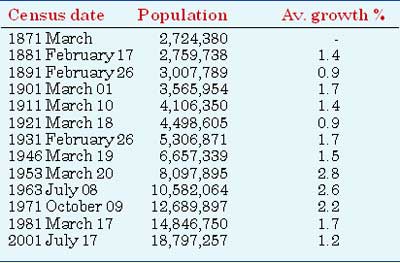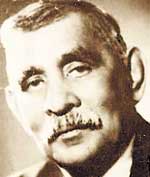How our population grew
 The first Census of Population after Independence was held on March 20, 1953. The number recorded was 8,097,895 showing an annual increase of 2.8% . The first Census of Population after Independence was held on March 20, 1953. The number recorded was 8,097,895 showing an annual increase of 2.8% .
The United Nations defines the Population Census as the total process of collecting, compiling, evaluating, analyzing and publishing demographic, economic and social data pertaining, at a specified time, in a country or in a well delimited part of a country.
Sri Lanka has a long history of census taking. The first scientific census was conducted in 1871 when the recorded population was 2.4 million. After 137 years, today the estimated figure is 20 million. Since 1871, 13 censuses have been conducted, once in ten years with a few exceptions. Generally March has been the month selected for taking the
census.
From 2.4 million, the population had increased to 18.8 million (males 9.36m & females 9.44m) in 2001 when the last census was conducted on July 17. It was held after a lapse of 20 years due to problems in the North & East. In 1981, the population was 14.8 million.
In 2001, the total population enumerated in the 18 districts, as a whole where the 2001 census was done completely on the final census night was 16,929,689. Since the enumeration was able to carry out completely in 18 out of 25 districts, estimates were made for areas where the census was not completed and the total population in Sri Lanka was 18.8 million. This shows an annual growth rate of 1.2 percent during the intercensal period 1981 and 2001.
Sri Lanka's population is ever increasing and recorded nearly an eight-fold increase since the first census in 1871. There was a dramatic escalation in growth rates during post world war, from 1946 to 1953 mainly due to the decline in mortality. Since 1953 population growth is steadily declining.
The above table shows the population trends over the years. |

 The first Census of Population after Independence was held on March 20, 1953. The number recorded was 8,097,895 showing an annual increase of 2.8% .
The first Census of Population after Independence was held on March 20, 1953. The number recorded was 8,097,895 showing an annual increase of 2.8% . The sudden death of
D. S. Senanayake, first Prime Minister of Independent Sri Lanka occurred 56 years ago this week. He was used to riding his horse at Galle Face and on March 22, 1952 he fell while riding and died the next day. He was 68.
The sudden death of
D. S. Senanayake, first Prime Minister of Independent Sri Lanka occurred 56 years ago this week. He was used to riding his horse at Galle Face and on March 22, 1952 he fell while riding and died the next day. He was 68.